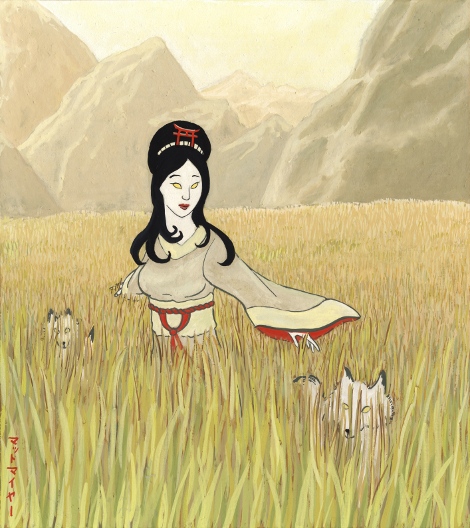Another widely popular kami, Inari is a god of fertility, agriculture, rice, foxes, industry, and worldly success. There are shrines to Inari all over Japan, the most famous one being Fushimi Inari in Kyoto, known for it’s thousands of torii archways. Inari is a patron of blacksmiths and a protector of warriors. In a famous Noh play, Inari helps the legendary blacksmith Munechika forge a great sword. And today, big corporations often have shrines to Inari on the top of their headquarters. (Take an elevated train ride through an urban area and you’re bound to see a number of rooftop shrines; a good number of them may be to Inari.)
Figuring out how to paint Inari was a difficult decision. There’s not really a “standard” appearance — sometimes Inari is depicted as a beautiful young woman, other times as a grizzly old man, other times as a warrior spirit, other times as an androgynous bodhisattva. In some stories, he appears as a snake, a dragon, or a giant spider. Throughout all the depictions though, one constant is foxes. Inari is strongly associated with foxes (kitsune), which is why you’ll see fox statues all over any placed dedicated to him.
Inari’s origins are pretty mysterious too. While he is a completely Shinto deity, he is often identified with other gods and goddesses, including the other gods of agriculture, Benzaiten of the Seven Lucky Gods, and even his wife. In some places, Inari is actually worshiped as a collective of three or five major deities, which over the centuries have included Izanagi and Izanami, the creator deities, and almost a dozen others. We’ll get to some of them later in the series, but that’s just to illustrate Inari’s importance in Shinto. Anyway, for my illustration, I went with the image of Inari as Dakiniten, a goddess imported from Tibetan Buddhism’s dakini — enlightened energy embodied in goddess form.

Inari
Lastly, if you’re a fan of sushi, you must be familiar with inari-zushi, rice inside a pocket of fried tofu. Foxes are said to love fried tofu, which is why the food was named after Inari. Oh yeah, and I wanted to mention Inari’s wife, Ukemochi, one more time, because the story is fantastic:
Ukemochi, a goddess of food, was preparing a feast for the moon god Tsukuyomi. She did this by facing the ocean and spat up a huge fish, then facing the forest, after which a vast herd of game spewed from her anus. Finally she faced a rice paddy and coughed up a big bowl of rice for him. Tsukuyomi was so disgusted he killed her right then and there, but her dead body continued to produce food: millet, rice, and beans sprouted forth from her corpse, and her eyes turned into silkworms.
I wonder what she was going to make for dessert.
This print is available on my Etsy store. If you’re interested in buying the original, please email me. Thanks for reading!

I think you did a lovely piece. The decision must have been difficult. Did you just start and see what developed? Or did something inspire you to take this direction? Oh, and by the way, I’m envious of those thunderstorms with snow. ~grin~ That must be wonderful.
Well there’s always some kind of inspiration; I look at lots of woodblock prints and paintings before I do one of these pictures. All of the different depictions of Inari were really interesting, but ultimately I went this this one because of the background. Deciding what scene to paint is sometimes harder than deciding how to paint the character, and I thought this form of Inari went best with the rice field.
Yeah, the snow thunderstorms are great. We’re getting dumped on with a huge snowstorm now; it’s already up to my knees and continuing to snow.